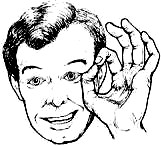Rubbing the palms together

- Rubbing the palms together - Rubbing the palms together is a way in which people non-verbally communicate positive expectation.
Hands Clenched Together

Research by Nierenberg and Calero on the hands-clenched position brought them to the conclusion that this was a frustration gesture, signalling that the person was holding back a negative attitude. The gesture has three main positions,
- The person would be more difficult to handle when the hands are held high, than he would be with the person whom hands resting on the desk position. Like all negative gestures, some action needs to be taken to unlock the person’s fingers to expose the palms and the front of the body, or the hostile attitude will remain.
Steepling Hands

People who are confident, superior types or who use minimal or restricted body gestures often use this gesture, and, by doing so, they signal their confident attitude. It is frequently used in superior/subordinate interaction and that it can be an isolated gesture which indicates a confident or 'know-it-all' attitude. Managers often use this gesture position when giving instructions or advice to subordinates and it is particularly common among accountants, lawyers, managers and the like. The gesture has two versions,
- The Raised Steeple - The position is normally taken when the steepler is giving his opinions or ideas and is doing the talking.
- The Lowered Steeple - The position is normally used when the steepler is listening rather than speaking.
Gripping Hands, Arms and Wrists

- Superiority/Confidence Gesture - Several prominent male members of the British Royal Family are noted for their habit of walking with their head up, chin out and one palm gripping the other hand behind the back. Not only does British Royalty use this gesture; it is common among Royalty of many countries. On the local scene, the gesture is used by the policeman patrolling his beat, the headmaster of the local school when he is walking through the school yard, senior military personnel and others in a position of authority.
- Hand-Gripping-Wrist Gesture - which is a signal of frustration and an attempt at self-control. In this ase one hand grips the other wrist or arm very tightly as if it is an attempt by one arm to prevent the other from striking out.
- Upper Arm Grip Gesture - The further the hand is moved up the back, the more angry the person has become. He is showing a greater attempt at self-control than the man in Hand-Gripping-Wrist Gesture man, because the hand is gripping the upper arm, not just the wrist. It is this type of gesture that has given rise to such expressions as, 'Get a good grip on yourself'.
Thumb Displays

The thumbs denote strength of character and ego and the non-verbal use of thumbs agrees with this. They are used to display dominance, superiority or even aggression; thumb gestures are secondary gestures, a supportive part of a gesture cluster. Thumb displays are positive signals, often used in the typical pose of the 'cool' manager who uses them in the presence of subordinates.
- Dominant Male - Arms folded with thumbs pointing upwards is another popular thumb gesture position. This is a double signal, being that of a defensive or negative attitude, (folded arms) plus a superior attitude (displayed by the thumbs). The person using this double gesture usually gesticulates with his or her thumbs, and rocking on the balls of the feet when standing is common.
- Dominant Female - Dominant or aggressive women also use this gesture. The women’s movement has allowed them to adopt many male gestures and positions. In addition to all this, thumb thrusters will often rock on the balls of their feet to give the impression of extra height.



































